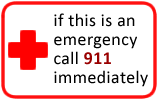Infection Exposure Questions - Contagiousness
Infection Exposure Questions - Contagiousness
Infection Exposure Table DISEASE |
INCUBATION PERIOD (DAYS) |
CONTAGIOUS PERIOD (DAYS) |
Skin Infections/Rashes: |
||
Chickenpox |
10-21 |
2 days before rash until all sores have crusts (6 - 7days) |
Fifth disease (Erythema infectiosum) |
4-14 |
7 days before rash until rash begins |
Hand, foot, and mouth disease |
3-6 |
Onset of mouth ulcers until fever gone |
Impetigo (strep or staph) |
2-5 |
Onset of sores until 24 hours on antibiotic |
Lice |
7 |
Onset of itch until 1 treatment |
Measles |
8-12 |
4 days before rash until 4 days after rash appears |
Roseola |
9-10 |
Onset of fever until rash gone (2 days) |
Rubella (German measles) |
14-21 |
7 days before rash until 5 days after rash appears |
Scabies |
30-45 |
Onset of rash until 1 treatment |
Scarlet fever |
3-6 |
Onset of fever or rash until 24 hours on antibiotic |
Shingles (contagious for chicken pox) |
14-16 |
Onset of rash until all sores have crusts (7 days) (Note: No need to isolate if sores can be kept covered.) |
Warts |
30-180 |
Minimally contagious |
Respiratory Infections: |
||
Bronchiolitis |
4-6 |
Onset of cough until 7 days |
Colds |
2-5 |
Onset of runny nose until fever gone |
Cold sores (herpes) |
2-12 |
Footnote 1 |
Coughs (viral) or croup (viral) |
2-5 |
Onset of cough until fever gone |
Diphtheria |
2-5 |
Onset of sore throat until 4 days on antibiotic |
Influenza |
1-2 |
Onset of symptoms until fever gone over 24 hours |
Sore throat, strep |
2-5 |
Onset of sore throat until 24 hours on antibiotic |
Sore throat, viral |
2-5 |
Onset of sore throat until fever gone |
Tuberculosis |
6-24 months |
Until 2 weeks on drugs (Note: Most childhood TB is not contagious.) |
Whooping cough |
7-10 |
Onset of runny nose until 5 days on antibiotic |
Intestinal Infections: |
||
Diarrhea, bacterial |
1-5 |
Footnote 2 for Diarrhea Precautions |
Diarrhea, giardia |
7-28 |
Footnote 2 for Diarrhea Precautions |
Diarrhea, traveler's |
1-6 |
Footnote 2 for Diarrhea Precautions |
Diarrhea, viral (Rotavirus) |
1-3 |
Footnote 2 for Diarrhea Precautions |
Hepatitis A |
14-50 |
2 weeks before jaundice begins until jaundice resolved (7 days) |
Pinworms |
21-28 |
Minimally contagious, staying home is unnecessary |
Vomiting, viral |
2-5 |
Until vomiting stops |
|
|
|
Other Infections: |
||
Infectious mononucleosis |
30-50 |
Onset of fever until fever gone (7 days) |
Meningitis, bacterial |
2-10 |
7 days before symptoms until 24 hours on IV antibiotics in hospital |
Meningitis, viral |
3-6 |
Onset of symptoms and for 1-2 weeks |
Mumps |
12-25 |
5 days before swelling until swelling gone (7 days) |
Pinkeye without pus (viral) |
1-5 |
Mild infection, staying home is unnecessary |
Pinkeye with pus (bacterial) |
2-7 |
Onset of pus until 1 day on antibiotic eyedrops |
Notes
Cold sores: Less than 6 years old, contagious until cold sores are dry (4-5 days). No isolation if sores are on part of body that can be covered. More than 6 years old, no isolation necessary if beyond touching, picking stage.
Diarrhea Precautions: Contagious until stools are formed. Stay home until fever is gone, diarrhea is mild, blood and mucus are gone, and toilet-trained child has control over loose stools. Shigella and E-coli 0157 require extra precautions. Consult your child care provider regarding attendance restrictions.
Author and Senior Reviewer: Barton D. Schmitt, M.D.
Content Set: Pediatric HouseCalls Symptom Checker
Pediatric HouseCalls Symptom Checker
Updated:
March 22, 2017
